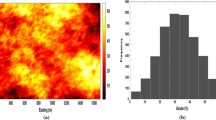Abstract
Mining applications commonly faces surprising high values designated as outliers. These values impact dramatically statistical analysis and interpretation. A comprehensive analysis on the causes for the presence of unexpected high values was recommended. However, if an erroneous value was accepted as a part of the solution, some form of correction is recommended. A methodology based on the robust kriging (RoK) algorithm is proposed to be used in exploratory data analysis and also to deal with problems associated with the presence of outliers in the sample data set. The efficiency of RoK method as an interpolator is tested in different types of mineralizations. Importantly, the parent population from which the data was sampled is available, thus allowing direct quantitative assessment of the effectiveness of the estimation technique. The performance of the method is tested in the context of ore reserves estimation. RoK model is compared to models generated by ordinary kriging, median indicator kriging, and lognormal kriging. RoK proved to be more accurate and more precise than those methods reducing substantially the number of misclassified blocks.
Similar content being viewed by others
REFERENCES
Barnett, V., and Lewis, T., 1984, Outliers in Statistical Data, 2nd ed. Wiley, Chichester, 463p.
Costa, J. F., 1997, Developments in recoverable reserves and ore body modelling: Unpublished doctoral dissertation, WH Bryan Mining Geology Research Centre, The University of Queensland, Queensland, Australia, 333p.
Costa, J. F., White, A. H., and Vilhena, M. T., 1996, Comparing the estimates resulting from ordinary and robust kriging, in Ramani, R., ed., 26th APCOM: Society of Mining Engineering—American Institute of Mining Engineering, U.S.A., September, p. 47-52.
Cressie, N., and Hawkins, D. M., 1980, Robust estimation of the variogram: Math. Geol., v.12, no.2, p. 115-125.
David, M., 1988, Handbook of applied advanced geostatistical ore reserve estimation: Elsevier Science, Netherlands, 216p.
Gomes, G. F. P., Rabelo, A., Forlim, R., Laybauer, L., Silva, F., and Marques, F., 1991, Geology and exploration of morro do ouro type deposits, in Proceedings of 1991 RTZ Exploration Conference, Rio Tinto, Salt Lake City, Utah. (unpublished)
Hawkins, D. M., and Cressie, N., 1984, Robust kriging—A proposal: Math. Geol., v.16, no.1, p. 3-17.
Isaaks, E., and Srivastava, M., 1989, An introduction to applied geostatistics: Oxford University Press, New York, 561p.
Journel, A. G., 1980, The lognormal approach to predicting local distributions of selective mining unit grades: Math. Geol., v.12, no.4, p. 285-303.
Journel, A. G., 1982, The indicator approach to estimation of spatial distributions, in Johnson, T. D., and Barnes, R. J., eds., 17th APCOM: Society of Mining Engineering, Golden, Colorado, p. 793-806.
Journel, A. G., and Arik, A., 1988, Dealing with outlier high grade data in precious metals deposits, in Fytas, K., Collins, J.-L., and Singhal, R. K., eds., Proceedings of Computer Application in the Mineral Industry—Canada: Balkema, Rotterdam, p. 161-171.
Krige, D., 1981, Lognormal—de Wijsian geostatistics for ore evaluation: South African Institute of Mining and Metallurgy, Johannesburg, 51p.
Pan, G., 1994, Restricted kriging: A link between sample value and sample configuration: Math. Geol., v.26, no.1, p. 135-155.
Parker, H., 1991, Statistical treatment of outlier data in epithermal gold deposit reserve estimation: Math. Geol., v.23, no.2, p. 175-199.
Parker, H., Journel, A. G., and Dixon, D. C., 1979, The use of conditional lognormal probability distribution for the estimation of open-pit ore reserves in stratabound uranium deposits—a case study, in O'Neil, T. J., ed., 16th APCOM: Society of Mining Engineering, Golden, Colorado, p. 133-147.
Rendu, J.-M., 1979, Normal and lognormal estimation: Math. Geol., v.11, no.4, p. 407-422.
Srivastava, M., 2001. Outliers—A guide for data analysts and interpreters on how to evaluate unexpected high values: Contaminated Sites Statistical Applications Guidance Document No. 12–8, British Columbia, Canada, 4p. Available at http:wlapwww.gov.bc.ca/epd/epdpa/contam_sites/guidance/technical/12.html
Weber, D. D., and Englund, E. J., 1992, Evaluation and comparison of spatial interpolation: Math. Geol., v.4, no.24, p. 381-391.
Author information
Authors and Affiliations
Rights and permissions
About this article
Cite this article
Costa, J.F. Reducing the Impact of Outliers in Ore Reserves Estimation. Mathematical Geology 35, 323–345 (2003). https://doi.org/10.1023/A:1023822315523
Issue Date:
DOI: https://doi.org/10.1023/A:1023822315523




